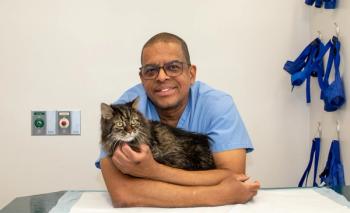
Understanding Salmonella and equine coronavirus in equine colitis diagnosis

Jamie Kopper, DVM, PhD, DACVIM (LAIM), DACVECC (LA), discussed common causes of colitis in adult horses in a CE session at Fetch Kansas City.
At the Fetch dvm360 Conference in Kansas City, Missouri, Jamie Kopper, DVM, PhD, DACVIM (LAIM), DACVECC (LA), assistant professor of equine internal medicine and emergency/critical care at Iowa State University, presented a lecture on acute colitis in horses. Among many other things, Kopper’s talk included common causes of colitis in adult horses, such as Salmonella and equine coronavirus, plus the diagnostic challenges veterinarians face when managing these organisms.
Salmonella
In adult horses, clinical signs of Salmonella may vary. Some patients may be asymptomatic carriers, appearing happy and healthy but still shedding the pathogen, whereas other horses may experience severe life-threatening colitis, sepsis, and/or endotoxemia.1 Meanwhile, others may only show mild signs of intermittent colic.1
Risk factors for shedding the bacteria include stress, colic—particularly small colon impactions—and antimicrobial use. During her lecture, Kopper shared that a large percentage of the hospitalized horses with Salmonella that she sees are patients under stress.
Kopper explained that the cause and effect of the relationship between the increased risk for shedding Salmonella and having a small colon impaction is still unknown. Still, she advised, “If you are taking horses into your hospital and you diagnose a small colon impaction, have your radar up from a biosecurity standpoint that this may be a horse that is at an increased risk of shedding Salmonella within your hospital or on a farm that you're working on.”
When it comes to diagnosing the bacterium, a culture and/or a polymerase chain reaction (PCR) test are both “excellent” options, according to Kopper. “One caveat I will put [out] is, unfortunately, this is a disease that is known for intermittent shedding. So, we know that with 1 negative sample, there's about a 50% chance [the patient] doesn’t have it. Three negative samples, about 75% chance [they] don't have it.” To be fully confident that a patient does not have Salmonella, 5 samples are required.1
“When I'm submitting a single sample...I will warn the clients that if we're really wanting to rule out Salmonella, [if] this comes back negative, we still don't have an answer yet, and it's still on our list of diseases to be concerned about,” Kopper said. “This is a disease that I will submit at least [another] 1 or 2 more samples for.”
To help clients save money, Kopper advises pooling manure samples from up to 5 horses instead of testing each horse separately. This method may be especially useful in herd outbreaks to reduce cost without losing test sensitivity.
When it comes to horses that were already diagnosed with Salmonella, and the goal is now to confirm that they are no longer an infectious disease risk to others, a culture is the better option over a PCR test, Kopper emphasized. She explained that this is because a PCR may still continue to detect DNA from dead Salmonella bacteria after the horse has stopped shedding the live, infectious organism. A culture, on the other hand, only detects live bacteria.
Equine coronavirus
Like Salmonella, clinical symptoms of equine coronavirus are also varied. “[Signs] could be the mildly colicky horse with a fever, it [could] be the horse with just some soft manure, it [could] be the horse with more severe diarrhea and colitis—so a whole gamut of clinical signs,” Kopper said. She noted that a reliable PCR test is available for detecting the disease.
Unfortunately, equine coronavirus is similar to Salmonella in more than just its varying clinical signs; affected horses also appear to exhibit intermittent shedding of the virus. “We don't have the same data worked out that we do with Salmonella, where we can say, ‘With 2 samples, you have this likelihood of picking it up; 3, you have this percent.’ But certainly, 1 sample is probably not enough to say, ‘Absolutely, that's not what's going on.’ So this is something that you and your client really want to circle back to [if you want to] be more confident that it's not what you're dealing with,” Kopper said.
“From a biosecurity standpoint, it does appear that they shed for weeks post infection,” she said. “And I think, similar to Salmonella, it's very variable [on a farm]. We may have 1 single horse that's affected, no one else is bothered by it, and other farms where you have the [full] outbreak that you're dealing with—[many] affected horses on the farm with varying degrees of clinical signs,” she said.
Reference
- Kopper J. Acute colitis in the horse. Presented at: Fetch dvm360 Conference; August 22, 2025; Kansas City, MO.
Newsletter
From exam room tips to practice management insights, get trusted veterinary news delivered straight to your inbox—subscribe to dvm360.






